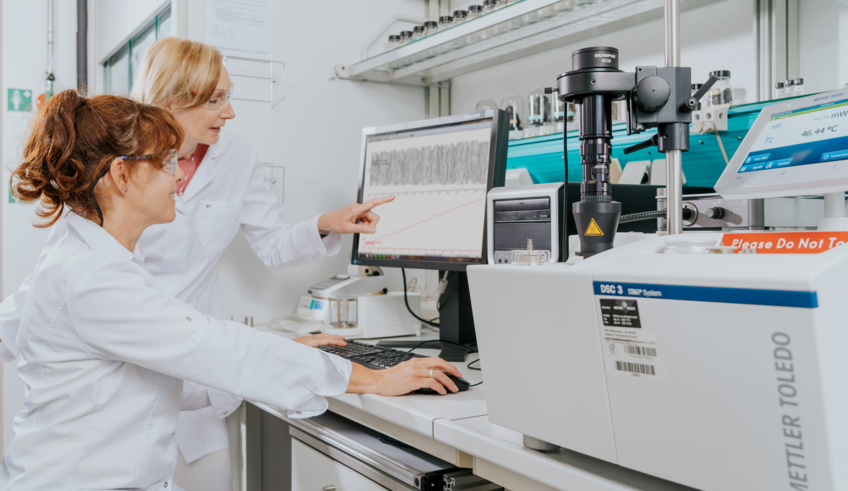
Separation process design
Goals within this topic are to gain a deeper understanding of the complex phase behavior of substances and substance/solvent systems (i.e. phase equilibria), the related crystallization kinetics and its consequences on separation process design. In this connection also development of improved measurement techniques, process modeling, and rationalization of process design is important.
Solid-liquid equilibria (SLE), i.e. equilibria between solid and liquid phases, are the thermodynamic foundation of crystallization processes and therefore their knowledge of essential importance for crystallization process design. Based on the solubility data and thermal analysis, we derive the phase diagrams as initial point for separation process design. Thermodynamic models and experimental tools are combined to have a fundamental understanding of the complex systems. Examples investigated in the last years originate from the fine chemical sectors, and relate to, for example, the resolution of chiral systems, the characterization and separation of solid solution forming systems or the isolation of certain target compounds from multi-component mixtures based on plant extracts.
Solid-state forms of Active Pharmaceutical Ingredients (APIs) comprise polymorphs, solvates, salts, co-crystals (binary compounds), solid solutions and amorphous forms. These different phases show diverse properties, such as solubility, dissolution rate and bioavailability. New solid-state forms can thus significantly improve the chemical and physical properties of APIs or may be used for separation purposes. In that regard we studied within the last years several amino acid systems (e.g. L-valine/L-leucine and L-aspartic acid/L-glutamic acid) and the curcuminoids as main constituents of Curcuma Longa plant extracts.
Separation of solid solutions
The separation of solid solution systems is a challenging task. One example is the L-valine/L-leucine/water system characterized by full miscibility of the amino acids at the solid state with an alyotropic point [1]. Detailed phase equilibria predictions and measurements revealed a change of the pure component solubilities and, in particular, the alyotropic composition, with addition of an anti-solvent [2, 3], which lead to a hybrid separation process combining an evaporation and anti-solvent crystallization step able to bypass the alyotrope and therewith, to provide both amino acid solid solution components from a mixture. Process modeling showed that in a 5-stage isothermal dual counter-current crystallization, starting from a 25/75 wt/wt L-leucine/L-valine mixture, L-leucine and L-valine can be provided at both high purities and yields (see Figure below) [4]. The proof of principle of such an “alyotropic separation” was experimentally demonstrated for a 2-stage process in pilot plant scale [3].
![Simplified flow scheme of a 5-stage counter-current crystallization process exploiting three evaporation and two antisolvent crystallization stages for “alyotropic separation” of L-leucine and L-valine in aqueous solution (25°C, antisolvent acetone) together with predicted purities and yields [4].](/3536993/original-1732280665.jpg?t=eyJ3aWR0aCI6MjQ2LCJvYmpfaWQiOjM1MzY5OTN9--fb6fae43d1adc5e753730e5065abd6ecf66a228d)
[1] Sadeghi, M., Tenberg, V., Münzberg, S., Lorenz, H., Seidel-Morgenstern, A.: Phase equilibria of L-Valine/L-Leucine solid solutions. J. Mol. Liquids 340 (2021) 117315
[2] Tenberg, V., Sadeghi, M., Seidel-Morgenstern, A., Lorenz, H.: Bypassing thermodynamic limitations in the crystallization-based separation of solid solutions. Sep. Purif. Technol. 283 (2022) 120169
[3] Tenberg, V., Hokmabadi, M., Seidel-Morgenstern, A., Lorenz, H. and Sadeghi, M.: Investigation of the Antisolvent Effect on the Phase Behavior of Amino Acid Solid Solutions. Ind. Eng. Res. Des. 62 (2023), pp. 753–761
[4] Tenberg, V. (2023). Separation of Solid Solutions using Counter-Current Crystallization: Improved Operation through Antisolvents. PhD Thesis, Otto-von-Guericke-Universität Magdeburg.
Further Publications
Tan, Q., Hosseini, S. A., Seidel-Morgenstern, A., Thévenin, D. Lorenz, H.: Thermal effects connected to crystallization dynamics: A lattice Boltzmann study. Int. J. Multiphase Flow 171 (2024) 104669
Bhandari, S., Lorenz, H., Seidel-Morgenstern, A.: Shortcut model to evaluate the performance of continuous preferential crystallization for conglomerates forming chiral systems. Chem. Eng. Sci. 299 (2024) 120539
Tenberg, V., Schultheis, A., Seidel-Morgenstern, A., Lorenz, H. and Sadeghi, M.: Solid phase miscibility and polymorph stabilization in the aqueous L-Asp/L-Glu system. Cryst. Growth Des. 24 (2024), pp. 9146–9153
Tan, Q., Hosseini, S.A., Seidel-Morgenstern, A., Thévenin, D. Lorenz, H.: Mandelic acid single-crystal growth: Experiments vs. numerical simulations. Commun. Comput. Phys. 33 (2023), pp.77–100
Alavia, W., Seidel-Morgenstern, A., Hermsdorf, D., Lorenz, H., Graber, T.: Real-time crystal growth monitoring of boric acid from sodium or lithium sulfate containing aqueous solutions by atomic force microscopy. ACS Omega 8 (2023), pp. 10822–10835
Kotelnikova, E. N, Isakov, A. I., Sadovnichii, R.V., Lorenz, H.: Solid phase relationships in systems of amino acids in connection with their participation in geological and technological processes. In: Marin, Y. (Ed.): XIII General Meeting of the Russian Mineralogical Society & the Fedorov Session (GMRMS 2021), Springer Proceedings in Earth and Environmental Sciences (SPEES), Cham (Switzerland), 2023, ISBN 978-3-031-23390-6 (doi.org/10.1007/978-3-031-23390-6_80, pp. 637–645)
Tenberg, V., Stein, M., Lorenz, H.: Solid phase and stability investigation of a co-crystal in the L-Val/L-Leu system. Crystals 13 (2023), 1542
Tan, Q., Hosseini, S.A., Seidel-Morgenstern, A., Thévenin, D., Lorenz, H.: Modeling ice crystal growth using the lattice Boltzmann method. Phys. Fluids 34 (2022) 013311
Saikia, B., Seidel-Morgenstern, A., Lorenz, H.: Multicomponent Materials to Improve Solubility: Eutectics of Drug Aminoglutethimide. Crystals 12 (2022), 40
Wünsche, S., Yuan, L., Seidel-Morgenstern, A., Lorenz, H.: A contribution to the solid state forms of bis(demethoxy)curcumin: Co-crystal screening and characterization. Molecules 26 (2021), 720
Sadovnichii, R., Kotelnikova, E., Lorenz, H.: Thermal deformations of crystal structures in the L-aspartic acid/L-glutamic acid system and DL-aspartic acid. Crystals 11 (2021), 1102
Sadeghi, M., Cascella, F., Tenberg, V., Seidel-Morgenstern, A, Lorenz, H.: Solubility analysis of pharmaceuticals guaifenesin, ketoprofen, and artemisinin in different solvents. J. Mol. Liquids 343 (2021) 117503
Saikia, B., Seidel-Morgenstern, A., Lorenz, H.: Role of mechanochemistry in solid form selection and identification of the drug praziquantel. Cryst. Growth Des. 21 (2021) pp. 5854-5861
![Simplified flow scheme of a 5-stage counter-current crystallization process exploiting three evaporation and two antisolvent crystallization stages for “alyotropic separation” of L-leucine and L-valine in aqueous solution (25°C, antisolvent acetone) together with predicted purities and yields [4]. Simplified flow scheme of a 5-stage counter-current crystallization process exploiting three evaporation and two antisolvent crystallization stages for “alyotropic separation” of L-leucine and L-valine in aqueous solution (25°C, antisolvent acetone) together with predicted purities and yields [4].](/3536993/original-1732280665.jpg?t=eyJ3aWR0aCI6MzQxLCJmaWxlX2V4dGVuc2lvbiI6ImpwZyIsIm9ial9pZCI6MzUzNjk5M30%3D--033dc20805ba856dcf3dde4932007a1f1b4d3a99)